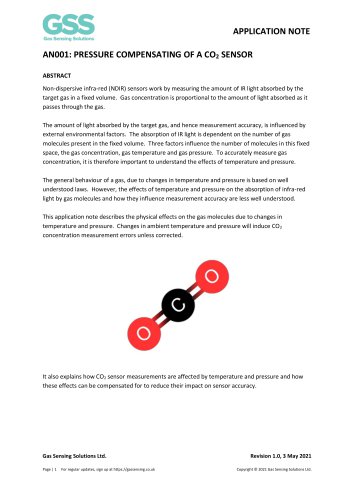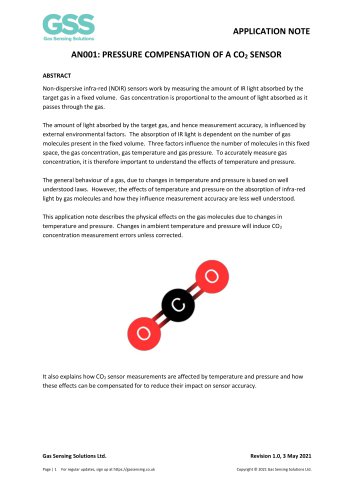
カタログの抜粋
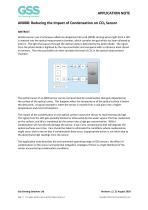
APPLICATION NOTE AN008: Reducing the Impact of Condensation on CO2 Sensor ABSTRACT All GSS sensors use a technique called non-dispersive infra-red (NDIR) sensing where light from a LED is injected into the optical measurement chamber, which contains the gas which has been allowed to enter it. The light that passes through the optical cavity is detected by the photo diode. The signal from the photo diode is digitised by the microcontroller and compared with a reference level stored in memory. The microcontroller can then calculate the level of CO2 in the optical measurement chamber. The performance of an NDIR sensor can be compromised by condensation that gets deposited on the surface of the optical cavity. This happens when the temperature of the optical surface is below the dew point. A typical example is when the sensor is moved from a cold place into a higher temperature and moist atmosphere. The impact of the condensation on the optical surface causes the sensor to read erroneously high. The signal from the LED gets partially blocked or attenuated by the water vapour that has condensed on the surface, and this is translated by the sensor into a high gas concentration. Whilst condensation will not directly damage the sensor, it can carry contaminants that will degrade the optical surfaces over time. Care should be taken to eliminate the conditions where condensation might occur and to ensure that if condensation does occur, inappropriate action is not taken due to the abnormally high readings from the sensor. This application note describes the environmental operating range of GSS sensors, the effect of condensation on the sensor and potential mitigation strategies if there is a high likelihood of the sensor encountering condensation conditions. Gas Sensing Solutions Ltd. Page | 1 For regular updates, sign up at https://gassensing.co.uk Revision 1.2, 21 August 2020 Copyright © 2021 Gas Sensing Solutions Ltd.
カタログの1ページ目を開く
Gas Sensing Solutions Ltd. Page | 2 For regular updates, sign up at https://gassensing.co.uk Revision 1.2, 21 August 2020 Copyright © 2021 Gas Sensing Solutions Ltd.
カタログの2ページ目を開く
APPLICATION NOTE AN008: Reducing the Impact of Condensation on CO2 Sensor CAUSES OF CONDENSATION Condensation is caused due to water vapour in the air or gas depositing itself on solid surfaces that are at lower temperatures than the surrounding air. When moist air or gas containing water vapour comes into contact with a cold impermeable surface, it releases some of this moisture onto the surface as water droplets. This is condensation. The dew point is the temperature at which the moist air or gas becomes saturated with water vapor, which is the gaseous state of water. When the gas...
カタログの3ページ目を開く
APPLICATION NOTE AN008: Reducing the Impact of Condensation on CO2 Sensor SENSOR OPERATING RANGE GSS sensors are available in two temperature range options, 0°C to 50°C and -25°C to 55°C. Both sensor types are designed to operate in non-condensing environments up to 95% relative humidity. However, using the above formula, at 95% relative humidity, there is only a 1°C difference between the ambient temperature and the dew point temperature. Gas Sensing Solutions Ltd. Page | 4 For regular updates, sign up at https://gassensing.co.uk Revision 1.2, 21 August 2020 Copyright © 2021 Gas Sensing S
カタログの4ページ目を開く
APPLICATION NOTE AN008: Reducing the Impact of Condensation on CO2 Sensor EFFECTS OF CONDENSATION GSS sensors are designed to work in a non-condensing environment at up to 95% RH. The function and performance of the sensor are likely to be affected by operating below the dew point. Whilst short term exposure to pure water is unlikely to affect long term performance, water condensing on the gas measurement cavity surfaces will have a temporary impact on measurement accuracy. Care must be taken to ensure the surface temperature of the sensor mirror surface does not drop below the dew point....
カタログの5ページ目を開く
APPLICATION NOTE AN008: Reducing the Impact of Condensation on CO2 Sensor DESICCANTS In some applications, it may be possible to use a desiccant close to the sensor to reduce the humidity levels and prevent condensation. Note that silica gel should not be used as this absorbs CO2 thus corrupting the measurement. Desiccants are generally limited in their application as the desiccant will need to be changed once it becomes saturated or baked to expel moisture. PHYSICAL FILTERS Increasing the physical filters between the sensor and the humid air or gas can also reduce the effect of...
カタログの6ページ目を開く
APPLICATION NOTE AN008: Reducing the Impact of Condensation on CO2 Sensor PHYSICAL LOCATION AND ORIENTATION If condensation does form on the optical surfaces (or elsewhere in the sensor) the long-term effect can potentially be mitigated by orienting the sensor, so the condensation does not collect in the optics but runs out of the optics. Note this does not prevent condensation, but it does speed up the recovery from condensation, for example after a step change in temperature. It also reduces the long-term degradation due to repeated condensation/evaporation cycles. For ExplorIR® and...
カタログの7ページ目を開く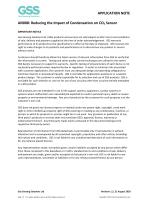
APPLICATION NOTE AN008: Reducing the Impact of Condensation on CO2 Sensor IMPORTANT NOTICE Gas Sensing Solutions Ltd. (GSS) products and services are sold subject to GSS’s terms and conditions of sale, delivery and payment supplied at the time of order acknowledgement. GSS warrants performance of its products to the specifications in effect at the date of shipment. GSS reserves the right to make changes to its products and specifications or to discontinue any product or service without notice. Customers should therefore obtain the latest version of relevant information from GSS to verify...
カタログの8ページ目を開く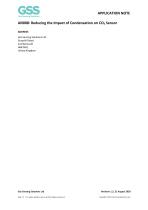
APPLICATION NOTE AN008: Reducing the Impact of Condensation on CO2 Sensor ADDRESS Gas Sensing Solutions Ltd. Grayshill Road Cumbernauld G68 9HQ United Kingdom Page | 9 For regular updates, sign up at https://gassensing.co.uk Copyright © 2021 Gas Sensing Solutions Ltd.
カタログの9ページ目を開く
APPLICATION NOTEAN008: Reducing the Impact of Condensation on CO2 Sensor REVISION HISTORY DATE Page | 10 For regular updates, sign up at https://gassensing.co.uk Copyright © 2021 Gas Sensing Solutions Ltd.
カタログの10ページ目を開くGas Sensing Solutions (GSS)のすべてのカタログと技術パンフレット
-
CO2 Sensor Response Time
12 ページ
-
Zeroing a CO2 Sensor
11 ページ
-
SprintIR-W Data Sheet
36 ページ
-
SprintIR-R Data Sheet
31 ページ
-
SprintIR-6S Data Sheet
31 ページ
-
ExplorIR-W Data Sheet
33 ページ
-
What is fresh Air
7 ページ
-
ExplorIR-M Data Sheet
28 ページ
-
CozIR-LP3 Data Sheet
53 ページ
-
CozIR-LP2 Data Sheet
40 ページ
-
CozIR-LP Data Sheet
29 ページ
-
CozIR-A Data Sheet
32 ページ
-
CozIR-Blink Data Sheet
37 ページ









